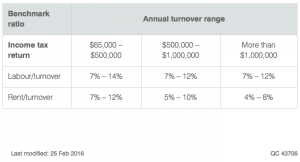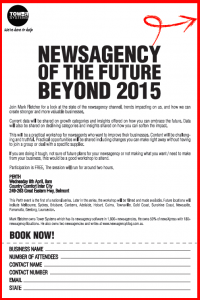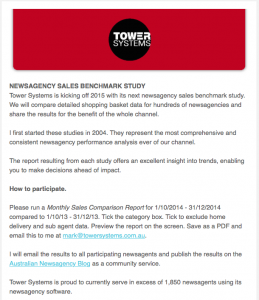Here are the results of my analysis of sales data from more than 140 newsagencies for January through March 2014 and the same period in 2013. While there is mixed news, the news is good for newsagents who work their businesses as engaged retailers.
Customer traffic. 61% of newsagents recorded an average decline of 2.3% in transactions. 17% reported no change and the rest an average growth of 3.2%.
Overall newsagency sales decline. 52% reported an average revenue decline of 4%. Of those reporting growth, the average was 5.8%.
Basket depth. 55% reported a decrease in basket size (items in the basket) with an average decrease was 2.3%. 4% showed no change. The rest achieved 1.7% growth.
Basket dollar value. 38% of newsagents an average increase in basket value of 2.2%.
Discounting. 11% of respondents engaged in discount based loyalty marketing.
The gap between growing and contracting newsagencies must be of concern to those dealing with newsagents nationally as it is more obvious than ever. Newsagencies are not once size fits all. There are some doing very well and others doing poorly.
It would be wrong to talk about newsagents and make a common statement about how they (we) are doing as there is no common situation.
Benchmark results by key departments:
1. Magazines. 67% of newsagents reported an average decline (in units) of magazine sales of 6.9%. 5% reported no change and 28% reported year on year magazine sales growth. The average growth was 4%. This is the headline: NEWSAGENTS CAN GROW MAGAZINE SALES.
Looking at the 28% reporting magazine sales growth, most growth was outside the weeklies with less than half of those growing this all-important category.
Partworks played a big role in the growth achieved by those achieving growth. In some cases, partworks accounted for close to 20% of all magazine sales.
2. Newspapers. 86% of newsagents reported an average decline of 5.8% in over the counter newspaper sales. HOWEVER: for most, revenue from newspapers was up! This is a reflection of significant cover price rises.
3. Greeting cards. 63% of newsagents reported average growth of 2.6%. Of those reporting a decline, the average was 4.7%. Everyday counter cards dominate card sales with this category accounting for between 50% and 60% of all cards sold in most newsagencies.
4. Stationery. 65% of newsagents reported an average decline of 3.1%. Of those reporting growth, the average was 5.8%. Notice the gap there?
5. Ink. 41% of stores report ink separately. Of these, 58% reported growth of 3%.
6. Gifts. 74% of the newsagents have a separate gift department. Of these, 78% reported average growth of 8%. In eight newsagencies, gift revenue exceeded card revenue.
7. Plush. 8% of newsagencies report on plush sales separately. I recommend this. A reasonable sales benchmark for plush is revenue equal to 25% of card revenue. In stores reporting on plush, sales are up on average 30%.
8. Tobacco. 82% of stores with tobacco reported an average decline of 13%.
9. Confectionery. 53% of stores reported an average decline of 7%.
10. Toys. 53% of stores with the department reporting growth of 6%.
The strong are getting stronger and the weak are getting weaker.
There is no geographic or demographic barrier to growth from what I can see. One newsagency in a town with tough economic challenges and competing with several newsagencies achieved excellent year on year growth – by owning their situation and being proactive.
Product mix shift. Embedded in the data I receive is information about unit sale and revenues contribution between all product categories. I can see a shift from the traditional print, lottery, card and stationery mix to a broader appeal by some. It is fascinating seeing the results of deliberate actions on the shop floor to attract more shoppers to a business.
In one business, looking back over some years, gifts have grown from accounting for 1% of revenue to accounting for 11% of revenue in three years. This achievement on the back of overall revenue growth reflects a significant shift in focus in this business.
Looking at my own newsagency for this quarter: calendars are up 61% off a good base, gifts are up 93% off a good base, card sales are up 11% with everyday counter cards up 17% – off an good base, magazine sales are up 11 off a good base, weekly magazines are up 4% and they account for 24.8% of total magazine sales, plush is up 44% off an extraordinary base – we did over $21,000 in plush in the quarter.
I mention that the numbers are off a good base to provide context. The growth I claim off a low base would not be as good as these results off a good base.
Number of sales, number of items per sale and average sale value all increased. Individually that is good. Compounded, as happens, it is excellent. The benefit to the bottom line of such compounding small steps is wonderful.
I include my own data here for comparison and to illustrate that I walk the walk with newsagents. When I encourage newsagents to try things it is because I do in my own business. I put my money where my mouth is.
This newsagency is in an outer suburban Westfield centre in Melbourne with around 300 stores including majors, another newsagents twelve gifts shops – plenty of nearby and price competitors for cards, gifts, magazines and plush.
I am happy to show my data to anyone who asks. I’m also happy to explain why my numbers are so strong. My phone number is 0418 321 338 and my email is mark@towersystems.com.au.
Newsagencies are good businesses to own. This study supports this belief. That many newsagents are reporting growth is magazines sales is a testament to the active engagement of those newsagents and their employees in this traffic-critical category.
The best type of newsagency to own is the one where you have the most control over what you sell and where you generate traffic for several product categories where average gross profit is 50% or higher.
The most important advice I have for newsagents has not changed: Run your business today as if today is your pay day. Too many newsagents continue to run their businesses as if their pay day is when they sell. This will not happen.
Newsagents: look at your business, your sources of traffic, your average GP. Your success will come from many small steps.
Suppliers: Get smart in your engagement with newsagents. Trust them. Treat them with respect. Share their mission to grow traffic and GP and basket value. Give newsagents complete control over what they sell of your products.
This year on year same store newsagency sales benchmark study is an analysis of sales basket data from 147 newsagencies – city and country, shopping centre and high street, banner groups (various) and independent. To be included, the businesses must have been using the same software for both analysis periods and to be compliant with industry software standards. I have done these benchmark studies for many years, drawing on my experience with the Tower Systems newsagent community. As the owner of Tower I have easier access to the data – not automatically and not without permission from newsagents. Around 63% of newsagents with a computer system use Tower. I have eliminated data from businesses where I knew that unique local factors impacted on the sales data.


